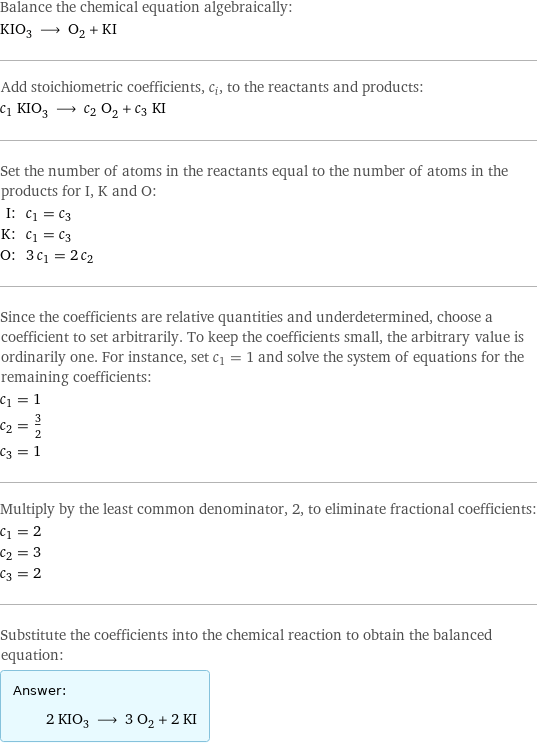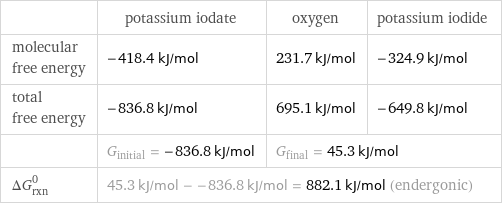Input interpretation

KIO_3 potassium iodate ⟶ O_2 oxygen + KI potassium iodide
Balanced equation

Balance the chemical equation algebraically: KIO_3 ⟶ O_2 + KI Add stoichiometric coefficients, c_i, to the reactants and products: c_1 KIO_3 ⟶ c_2 O_2 + c_3 KI Set the number of atoms in the reactants equal to the number of atoms in the products for I, K and O: I: | c_1 = c_3 K: | c_1 = c_3 O: | 3 c_1 = 2 c_2 Since the coefficients are relative quantities and underdetermined, choose a coefficient to set arbitrarily. To keep the coefficients small, the arbitrary value is ordinarily one. For instance, set c_1 = 1 and solve the system of equations for the remaining coefficients: c_1 = 1 c_2 = 3/2 c_3 = 1 Multiply by the least common denominator, 2, to eliminate fractional coefficients: c_1 = 2 c_2 = 3 c_3 = 2 Substitute the coefficients into the chemical reaction to obtain the balanced equation: Answer: | | 2 KIO_3 ⟶ 3 O_2 + 2 KI
Structures

⟶ +
Names

potassium iodate ⟶ oxygen + potassium iodide
Reaction thermodynamics
Enthalpy

| potassium iodate | oxygen | potassium iodide molecular enthalpy | -501.4 kJ/mol | 0 kJ/mol | -327.9 kJ/mol total enthalpy | -1003 kJ/mol | 0 kJ/mol | -655.8 kJ/mol | H_initial = -1003 kJ/mol | H_final = -655.8 kJ/mol | ΔH_rxn^0 | -655.8 kJ/mol - -1003 kJ/mol = 347 kJ/mol (endothermic) | |
Gibbs free energy

| potassium iodate | oxygen | potassium iodide molecular free energy | -418.4 kJ/mol | 231.7 kJ/mol | -324.9 kJ/mol total free energy | -836.8 kJ/mol | 695.1 kJ/mol | -649.8 kJ/mol | G_initial = -836.8 kJ/mol | G_final = 45.3 kJ/mol | ΔG_rxn^0 | 45.3 kJ/mol - -836.8 kJ/mol = 882.1 kJ/mol (endergonic) | |
Equilibrium constant
![Construct the equilibrium constant, K, expression for: KIO_3 ⟶ O_2 + KI Plan: • Balance the chemical equation. • Determine the stoichiometric numbers. • Assemble the activity expression for each chemical species. • Use the activity expressions to build the equilibrium constant expression. Write the balanced chemical equation: 2 KIO_3 ⟶ 3 O_2 + 2 KI Assign stoichiometric numbers, ν_i, using the stoichiometric coefficients, c_i, from the balanced chemical equation in the following manner: ν_i = -c_i for reactants and ν_i = c_i for products: chemical species | c_i | ν_i KIO_3 | 2 | -2 O_2 | 3 | 3 KI | 2 | 2 Assemble the activity expressions accounting for the state of matter and ν_i: chemical species | c_i | ν_i | activity expression KIO_3 | 2 | -2 | ([KIO3])^(-2) O_2 | 3 | 3 | ([O2])^3 KI | 2 | 2 | ([KI])^2 The equilibrium constant symbol in the concentration basis is: K_c Mulitply the activity expressions to arrive at the K_c expression: Answer: | | K_c = ([KIO3])^(-2) ([O2])^3 ([KI])^2 = (([O2])^3 ([KI])^2)/([KIO3])^2](../image_source/5d89266964dd22740e5db89e05f141bc.png)
Construct the equilibrium constant, K, expression for: KIO_3 ⟶ O_2 + KI Plan: • Balance the chemical equation. • Determine the stoichiometric numbers. • Assemble the activity expression for each chemical species. • Use the activity expressions to build the equilibrium constant expression. Write the balanced chemical equation: 2 KIO_3 ⟶ 3 O_2 + 2 KI Assign stoichiometric numbers, ν_i, using the stoichiometric coefficients, c_i, from the balanced chemical equation in the following manner: ν_i = -c_i for reactants and ν_i = c_i for products: chemical species | c_i | ν_i KIO_3 | 2 | -2 O_2 | 3 | 3 KI | 2 | 2 Assemble the activity expressions accounting for the state of matter and ν_i: chemical species | c_i | ν_i | activity expression KIO_3 | 2 | -2 | ([KIO3])^(-2) O_2 | 3 | 3 | ([O2])^3 KI | 2 | 2 | ([KI])^2 The equilibrium constant symbol in the concentration basis is: K_c Mulitply the activity expressions to arrive at the K_c expression: Answer: | | K_c = ([KIO3])^(-2) ([O2])^3 ([KI])^2 = (([O2])^3 ([KI])^2)/([KIO3])^2
Rate of reaction
![Construct the rate of reaction expression for: KIO_3 ⟶ O_2 + KI Plan: • Balance the chemical equation. • Determine the stoichiometric numbers. • Assemble the rate term for each chemical species. • Write the rate of reaction expression. Write the balanced chemical equation: 2 KIO_3 ⟶ 3 O_2 + 2 KI Assign stoichiometric numbers, ν_i, using the stoichiometric coefficients, c_i, from the balanced chemical equation in the following manner: ν_i = -c_i for reactants and ν_i = c_i for products: chemical species | c_i | ν_i KIO_3 | 2 | -2 O_2 | 3 | 3 KI | 2 | 2 The rate term for each chemical species, B_i, is 1/ν_i(Δ[B_i])/(Δt) where [B_i] is the amount concentration and t is time: chemical species | c_i | ν_i | rate term KIO_3 | 2 | -2 | -1/2 (Δ[KIO3])/(Δt) O_2 | 3 | 3 | 1/3 (Δ[O2])/(Δt) KI | 2 | 2 | 1/2 (Δ[KI])/(Δt) (for infinitesimal rate of change, replace Δ with d) Set the rate terms equal to each other to arrive at the rate expression: Answer: | | rate = -1/2 (Δ[KIO3])/(Δt) = 1/3 (Δ[O2])/(Δt) = 1/2 (Δ[KI])/(Δt) (assuming constant volume and no accumulation of intermediates or side products)](../image_source/dee911fd3ecfdd73f81ab2ddb844e610.png)
Construct the rate of reaction expression for: KIO_3 ⟶ O_2 + KI Plan: • Balance the chemical equation. • Determine the stoichiometric numbers. • Assemble the rate term for each chemical species. • Write the rate of reaction expression. Write the balanced chemical equation: 2 KIO_3 ⟶ 3 O_2 + 2 KI Assign stoichiometric numbers, ν_i, using the stoichiometric coefficients, c_i, from the balanced chemical equation in the following manner: ν_i = -c_i for reactants and ν_i = c_i for products: chemical species | c_i | ν_i KIO_3 | 2 | -2 O_2 | 3 | 3 KI | 2 | 2 The rate term for each chemical species, B_i, is 1/ν_i(Δ[B_i])/(Δt) where [B_i] is the amount concentration and t is time: chemical species | c_i | ν_i | rate term KIO_3 | 2 | -2 | -1/2 (Δ[KIO3])/(Δt) O_2 | 3 | 3 | 1/3 (Δ[O2])/(Δt) KI | 2 | 2 | 1/2 (Δ[KI])/(Δt) (for infinitesimal rate of change, replace Δ with d) Set the rate terms equal to each other to arrive at the rate expression: Answer: | | rate = -1/2 (Δ[KIO3])/(Δt) = 1/3 (Δ[O2])/(Δt) = 1/2 (Δ[KI])/(Δt) (assuming constant volume and no accumulation of intermediates or side products)
Chemical names and formulas

| potassium iodate | oxygen | potassium iodide formula | KIO_3 | O_2 | KI Hill formula | IKO_3 | O_2 | IK name | potassium iodate | oxygen | potassium iodide IUPAC name | potassium iodate | molecular oxygen | potassium iodide
Substance properties

| potassium iodate | oxygen | potassium iodide molar mass | 214 g/mol | 31.998 g/mol | 166.0028 g/mol phase | solid (at STP) | gas (at STP) | solid (at STP) melting point | 560 °C | -218 °C | 681 °C boiling point | | -183 °C | 1330 °C density | 1.005 g/cm^3 | 0.001429 g/cm^3 (at 0 °C) | 3.123 g/cm^3 surface tension | | 0.01347 N/m | dynamic viscosity | | 2.055×10^-5 Pa s (at 25 °C) | 0.0010227 Pa s (at 732.9 °C) odor | | odorless |
Units
